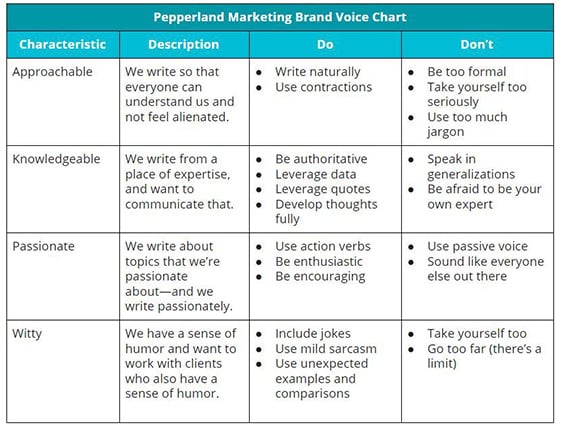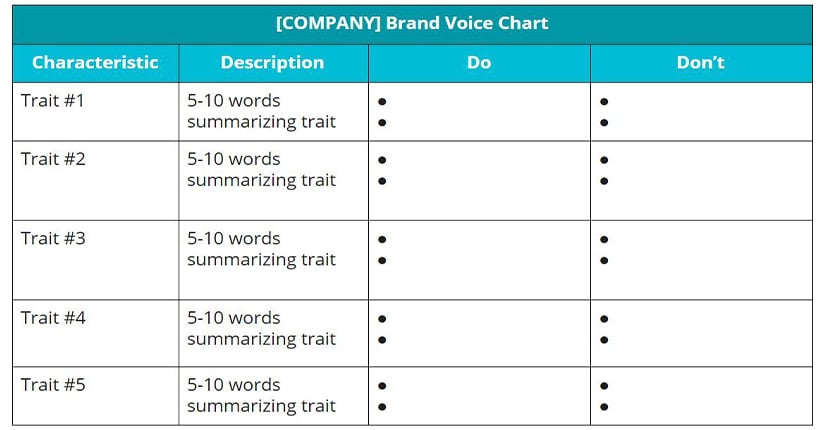Written By:
Tim Stobierski
If your organization has recently gone through the process of defining a brand voice, that’s great! But defining your brand voice is only the first step. You also need to ensure that everyone in your organization is using your brand voice consistently. A brand voice chart can help. Here, we explore:
-
What a brand voice chart is
-
How your organization can use a brand voice chart
-
Offer a template you can use to get started
Key Takeaways
Define brand voice: Pin down 3–5 adjectives that embody your company’s tone.
Summarize in a chart: List each trait with “why it matters” plus clear do’s and don’ts for writers.
Distribute to creators: Give the chart to everyone producing blogs, emails, ads, video, social, and more.
Embed in workflow: Attach it to editorial guidelines and keep printed copies visible for quick reference.
Customize a template: Brand-match colors/fonts and create separate charts when different audiences need distinct voices.
A few months ago, you read a marketing email written by a different member of your team and realized that it sounded very different from a similar email you had written a few weeks prior. Not different in content, but in its tone. It didn’t just sound like it had been written by a different person; it could have come from a different company altogether.
After doing a bit of digging, you realized that this was a trend not just in your email marketing, but across all of your channels. Social media posts, advertisements, mailers, blog posts, website copy—none of it was consistent.
It was clear that the company did not have a clear brand voice, and that fact was making it hard for you to build lasting relationships with your customers. It was hurting your image.
Ready to get started? Download our free Brand Voice Worksheet!
As a result of this observation, you took it upon yourself as a project to sit down and define, once and for all, a brand voice that resonates with your ideal buyer while encapsulating all of the principles that your company stands for. It was a significant undertaking, but you’ve succeeded, and you couldn’t be happier.
Time to put brand voice aside and find your next project, right?
Not so fast!
While defining your company’s brand voice is an important first step, it’s just that: A first step. Once you’ve defined your brand voice, you then need to make sure that all of the content creators in your company are channeling that brand voice when they create content.
Adding your brand voice guidelines to your editorial guidelines is one great way to accomplish this. Another? Creating and distributing a brand voice chart that quickly summarizes everything a content creator needs to know.
What is a brand voice chart?
A brand voice chart is, quite simply, a chart that summarizes your organization’s brand voice. It is meant to act as a quick reference for anyone responsible for creating content on your team.
They work like this: In defining your brand voice, one of the most important steps is identifying the qualities that you want your brand voice to embody. Typically, this list is limited to roughly three to five adjectives. Your brand voice chart organizes these qualities, explains why they are important, and quickly offers guidance about what a content creator should (and should not) do in order to embody the quality.
For example, consider the brand voice chart below:

In addition to outlining the key characteristics of the company’s brand voice, as well as an explanation of why these characteristics are important and how they influence content creation, the chart is also prescriptive in terms of what is and isn’t allowed—making it an actionable tool.
How do you use a brand voice chart?
The whole point of creating a brand voice chart is to ensure that everyone who creates content on your team stays on the same loop. That makes using the chart easy: Simply create your own chart and distribute it to anyone who might at some point be responsible for creating content!
And remember, content can take many different forms. Anyone responsible for working on any of the items below should have the chart to reference:
- Blog posts
- Website pages
- Landing pages
- Ebooks/content offers
- Calls-to-action (CTAs)
- Video
- Custom graphics
- Social media posts
- Advertisements
- Newsletters
- Mailers/fliers
The easiest way to ensure that your team is referencing your brand voice chart? First, you should consider adding it as an addendum to your editorial guidelines. Second, consider handing out physical copies, and encourage your content creators to pin them up in their cubicles or on their desks for quick reference.
It’s also worth noting that sometimes, an organization will have more than one brand voice, depending on how many audiences they may have. For example, a publicly-traded company may have one brand voice for communicating with potential buyers and customers, and a completely different brand voice for communicating with investors. That’s perfectly fine. If this is the case for you, you should create a brand voice chart for both audiences to remove any confusion.
Brand Voice Chart Template
Want to create your own brand voice chart? You can easily create your own table by following the outline below. Don’t want to start from scratch? Download our free brand voice worksheet, which includes a template for creating a brand voice chart (along with some other awesome tools)!

In creating your own brand voice chart, don’t be afraid to get creative. Adjust the colors and fonts to match your company’s branding. After all, if the brand voice chart is meant to help you keep all of your content cohesive, then it should itself mesh well with your other documentation.
Just Another Tool at Your Disposal
A brand voice chart, paired with other important pieces of documentation like your editorial guidelines and editorial mission statement, can make it much easier to ensure that all of your content is working towards a cohesive message and goal—and they’re all pretty easy to pull together. All you have to do is commit to getting started!








